The Metropolitan Museum of Art, New York
In celebration of the start of Passover tomorrow, two curators of medieval art invite readers to The Met Cloisters to view a recently acquired Hebrew Bible from the 14th century, and the Prato Haggadah, which is on loan from the Library of the Jewish Theological Seminary.

Text Messages: The Met Cloisters' Hebrew Bible, and the Prato Haggadah
Curator Barbara Boehm tells the histories of two Judaic manuscripts now on view at The Met Cloisters, in time for Passover.
METMUSEUM.ORG
...The crucial role of biblical study is charmingly illustrated in the Prato Haggadah, on display now at The Met Cloisters, a loan from the Library of the Jewish Theological Seminary. Though intended only for use at the Seder table, this Haggadah serves as a reminder that there is more to the holiday than feasting. Text and image accord a starring role to the teachings of Rabbi Gamliel, here dressed as a university professor, as he imparts wisdom about the exodus story to his students.
 Left: Prato Haggadah, ca. 1300. Spanish. Tempera, gold, and ink on parchment. The Library of the Jewish Theological Seminary, New York
Left: Prato Haggadah, ca. 1300. Spanish. Tempera, gold, and ink on parchment. The Library of the Jewish Theological Seminary, New York
Mindful of his focus, we are currently exhibiting the Bible's text of the "Song of the Sea" found in the book of Exodus. This song has particular resonance at Passover, as it celebrates the defeat of Pharaoh's army ("Horse and driver He has hurled into the sea,") and the miraculous escape of the Israelites from the Land of Egypt.
The survival of the Hebrew Bible verges on the miraculous, too. Names and dates penned inside its pages suggest that it left Spain by 1492, when the Jewish population was expelled. The Bible and its successive owners voyaged eastward along the Mediterranean, landing next in Greece, later in Egypt, returning still later to the European mainland. Today, it is one of only three surviving embellished Hebrew Bibles from fourteenth-century Castile.
We consider it a particular honor that it should end its travels at The Met Cloisters, where the Hebrew Bible will transform our presentation—and our visitors' understandings—of medieval manuscript illumination. All other books belonging to The Met Cloisters were created for Christian use (and three of them were made in Paris within a ninety-year period). This manuscript awakens us to the Jewish community that was a vibrant part of the culture of medieval Spain.
沒有留言:
張貼留言